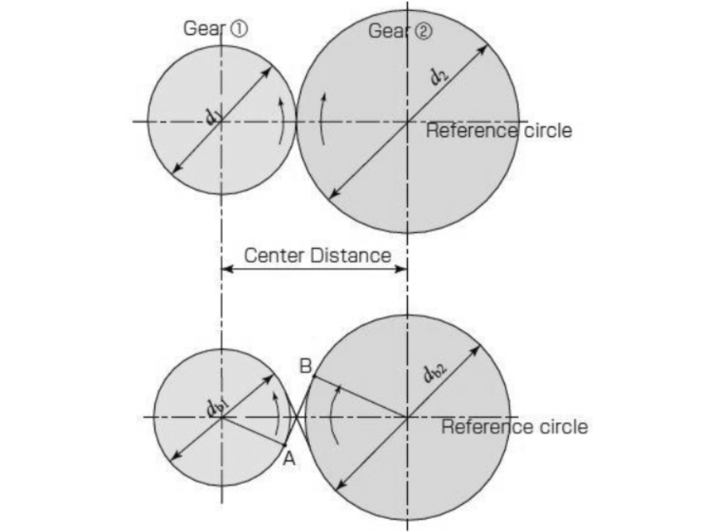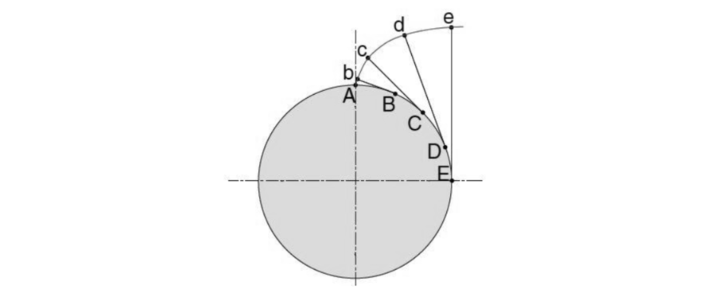- Home/
- GATE MECHANICAL/
- GATE ME/
- Article
Gear Profiles: Definition, Characteristics, and Meshing
By BYJU'S Exam Prep
Updated on: September 25th, 2023

The contour of the Gear Profiles is an essential element of gear design. Before we go into the details of Gear profiles, Let’s first understand what gear is. A gear is a machine element with toothed cylindrical or roller-shaped elements that mesh with another cylindrical element to transmit power from one shaft to another. It is primarily used to obtain different torque and speed ratios or to reverse the driving and driven shaft directions.
Gear Profiles PDF
Gear Profiles are essential for effective gear design. Involute curve tooth profiles are used in gears. Other types of gear profiles exist, although they are mostly used in specialized applications such as cycloidal gears in clocks and watches. Let’s take a deep dive into the concepts related to Gear Profile.
Download Formulas for GATE Mechanical Engineering – TOM & Vibrations
Table of content
What are Gear Profiles?
Gear profiles are the shapes of the teeth on a gear. The gear profile is typically described using a cross-sectional view of the gear, which shows the shape and dimensions of the teeth. Several gear profiles exist, including involute, cycloidal, and trochoidal. Each profile is as important as gear terminologies. Each profile type has unique characteristics and is suited to different applications.
The involute profile is the most common type of gear profile. It is characterized by a curve generated by the end of a taut string as it is unwrapped from the circumference of a circle. Involute gears are widely used because they have smooth and efficient meshing and can transmit high loads with minimal wear and noise. The cycloidal profile is characterized by circular arcs, typically used in low-speed and high-precision applications, and carries good weightage from the GATE ME syllabus. The trochoidal profile is characterized by alternating circular arcs and straight lines and is typically used in high-speed and high-load applications. The selection of the appropriate gear profile is important for the performance and efficiency of a gear system. Factors that may influence the selection of a gear profile include the application’s speed, load, precision, and noise requirements.
Download Formulas for GATE Mechanical Engineering – Manufacturing Engineering and Materials
Gear Tooth Profiles
Gear tooth profiles refer to the shapes of the teeth on a gear. The gear profile is typically described using a cross-sectional view of the gear, which shows the shape and dimensions of the teeth. There are several different types of gear tooth profiles, including involute, cycloidal, and trochoidal. Each profile type has unique characteristics and is suited to different applications. The involute profile is the most common type of gear tooth profile. It is characterized by a curve generated by the end of a taut string as it is unwrapped from the circumference of a circle. Involute gears are widely used because they have smooth and efficient meshing and can transmit high loads with minimal wear and noise.
The cycloidal profile is characterized by circular arcs and is typically used in low-speed and high-precision applications. The trochoidal profile is characterized by alternating circular arcs and straight lines and is typically used in high-speed and high-load applications. The selection of the appropriate gear tooth profile is important for the performance and efficiency of a gear system. Factors that may influence the selection of a gear tooth profile include the application’s speed, load, precision, and noise requirements.
Characteristics of Involute Gear Tooth Profiles
The profiles of the teeth in an involute gear are circular involutes. The involute of a circle is the spiraling curve generated by the end of an imaginary taut rope unwinding itself from the stationary circle, known as the base circle or a triangle wave projected on the circumference of a circle. The GATE ME exam may carry questions from the characteristics. The properties of Involute Gear Tooth Profiles are as follows.
-
Smooth and efficient meshing: Involute gears have smooth and efficient meshing, which allows them to transmit high loads with minimal wear and noise.
-
Constant tooth pressure: Involute gears have constant tooth pressure, which means that the forces acting on the teeth are evenly distributed and do not vary with rotation.
-
Constant contact ratio: Involute gears have a constant contact ratio, the ratio of the length of contact between the teeth to the width of the tooth. The constant contact ratio of involute gears allows them to transmit high loads with minimal wear and noise.
-
Constant pitch point velocity: Involute gears have a constant pitch point velocity, which is the velocity of the pitch point as the gears rotate. The constant pitch point velocity of involute gears allows them to transmit motion and torque smoothly and efficiently.
-
Constant tooth thickness: Involute gears have a constant tooth thickness, which means that the thickness of the teeth does not vary along the length of the tooth. The constant tooth thickness of involute gears allows them to transmit high loads with minimal wear and noise.
Download Formulas for GATE Mechanical Engineering – Strength of Materials
What is an Involute Gear Tooth Profile?
An involute gear tooth profile is a specific Gear profile characterized by a curve generated by the end of a taut string as it is unwrapped from the circumference of a circle. Involute gears are widely used because they have smooth and efficient meshing and can transmit high loads with minimal wear and noise.
The involute curve is used because it allows the teeth of the two gears to smoothly engage and disengage as the gears rotate. To mesh properly, the gears must be properly aligned, with the axes of the gears parallel and the distance between the gears (the center distance) set to the proper value. The teeth of the two gears must also have the same pitch, the distance from one tooth to the next measured along the pitch circle. As the gears rotate, the teeth mesh at the pitch point, which is the tangency point between the two gears’ pitch circles. The pitch point is where the gears transmit motion and torque to each other. Involute gear teeth are widely used in various applications, including internal combustion engines, pumps and compressors, and transmission systems.
Meshing of Involute Gear
The meshing of involute gears is the process by which the teeth of two gears interlock and transmit motion and torque to each other. Involute gears are widely used because they have smooth and efficient meshing and can transmit high loads with minimal wear and noise. In involute gear meshing, the teeth of the two gears are shaped as an involute curve, which is a curve that is generated by the end of a taut string as it is unwrapped from the circumference of a circle. The involute curve is used because it allows the teeth of the two gears to smoothly engage and disengage as the gears rotate.
To mesh properly, the gears must be properly aligned, with the axes of the gears parallel and the distance between the gears (the center distance) set to the proper value. The teeth of the two gears must also have the same pitch, the distance from one tooth to the next measured along the pitch circle. As the gears rotate, the teeth mesh at the pitch point, which is the tangency point between the two gears’ pitch circles; this is an important concept for the GATE exam. The pitch point is where the gears transmit motion and torque to each other. Involute gear meshing is a smooth and efficient process widely used in various applications, including internal combustion engines, pumps and compressors, and transmission systems.

Applications of Gear Profiles
Gear profiles are used in a variety of applications, including:
-
Internal combustion engines: Gear profiles are used in internal combustion engines to transmit rotational motion and torque from the pistons to the crankshaft.
-
Pumps and compressors: Pumps and compressors use gear profiles to transfer fluid or gas from one location to another.
-
Transmission systems: Gear profiles change the speed and torque of a rotating shaft, such as in a car transmission.
-
Robotics: Gear profiles are used in robotics to provide precise and repeatable motion for tasks such as welding or assembly.
-
Conveyor systems: Gear profiles are used in conveyor systems to move items along a production line.
-
Toy cars: Gear profiles transmit rotational motion and torque from the motor to the wheels.
-
Human-powered vehicles: Gear profiles are used in vehicles such as bicycles and rowing machines to transmit rotational motion and torque from the pedals or oars to the wheels or propellers.
Advantages of Gear Profiles
There are several advantages to using gear profiles:
-
Precision: Gear profiles can provide precise and repeatable motion, which is useful for tasks that require high levels of accuracy, such as assembly, welding, and painting.
-
Versatility: Gear profiles can perform a wide range of tasks, including transmitting rotational motion and torque, changing the speed and torque of a rotating shaft, and moving items along a production line.
-
Compactness: Gear profiles can be designed to be compact and lightweight, making them suitable for use in environments where space is limited.
-
Reliability: Gear profiles are generally reliable and can operate continuously for long periods of time without requiring maintenance.
-
Safety: Gear profiles can be designed to be safe for use around humans and can be equipped with sensors and other safety features to prevent accidents.
-
Cost: Gear profiles can be relatively inexpensive to design and build, especially compared to more complex mechanical systems.
Limitations of Gear Profiles
There are also some limitations to using gear profiles:
-
Limited range of motion: The range of motion of a gear profile is limited by the size and shape of the teeth and the constraints imposed by the gear housing.
-
Sensitivity to external forces: Gear profiles can be sensitive to external forces, such as wind or vibrations, affecting their performance.
-
Complexity: The gear design and control of gear profiles can be complex, especially for systems with many degrees of freedom.
-
Limited adaptability: Gear profiles are typically designed for specific tasks and may not be easily adaptable to new tasks or environments.
-
Wear and maintenance: Gear profiles can suffer from wear and tear over time and may require regular maintenance to keep them operating at their best.
-
Noise: Gear profiles can produce noise as they mesh and transmit motion and torque, which can be a concern in certain applications.
Get complete information about the GATE exam pattern, cut-off, and all those related things on the BYJUS Exam Prep official youtube channel.




